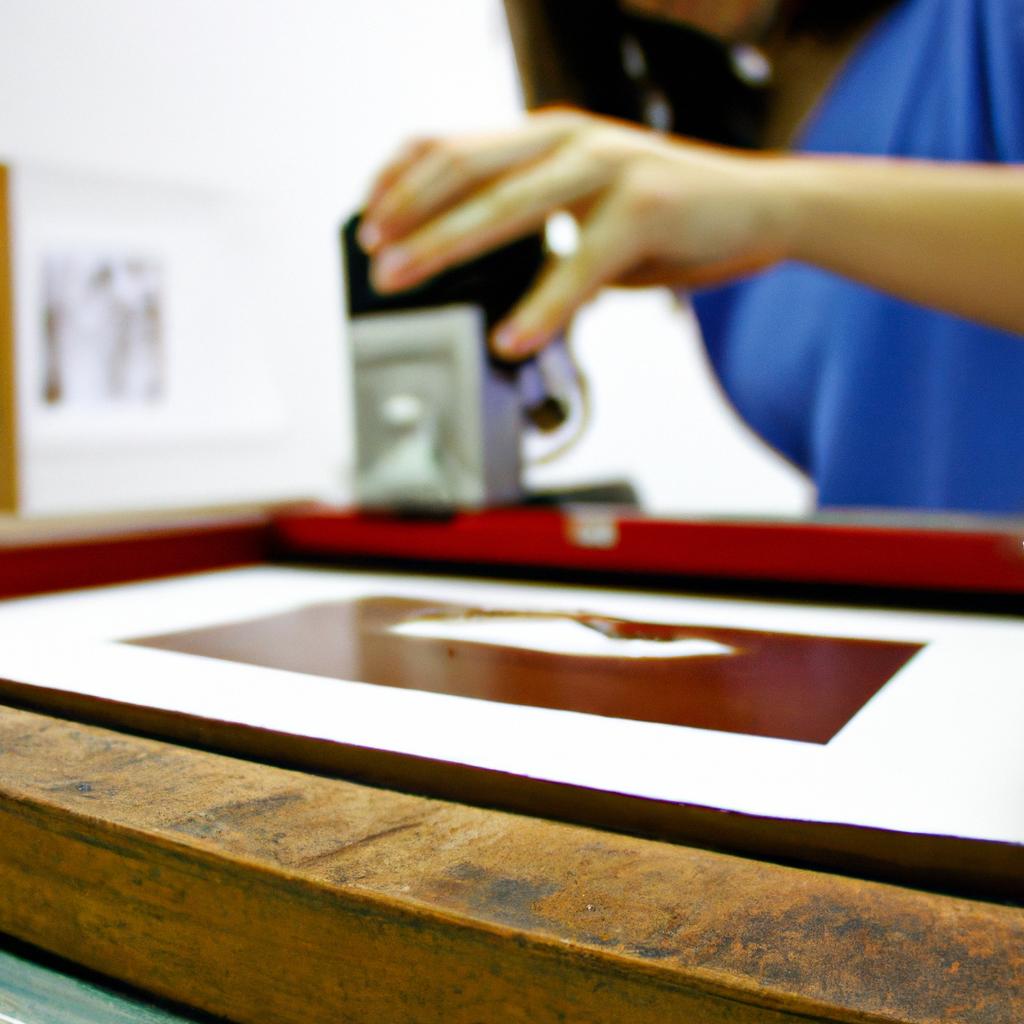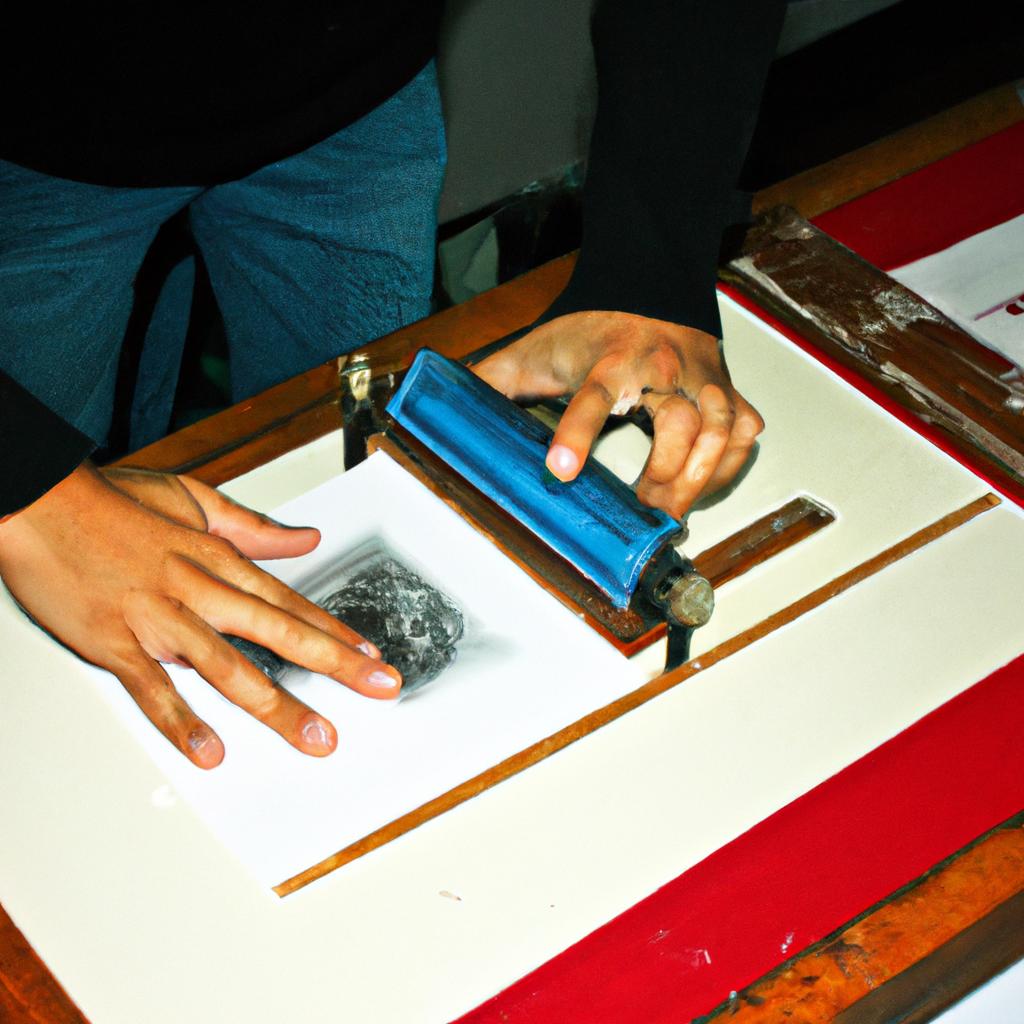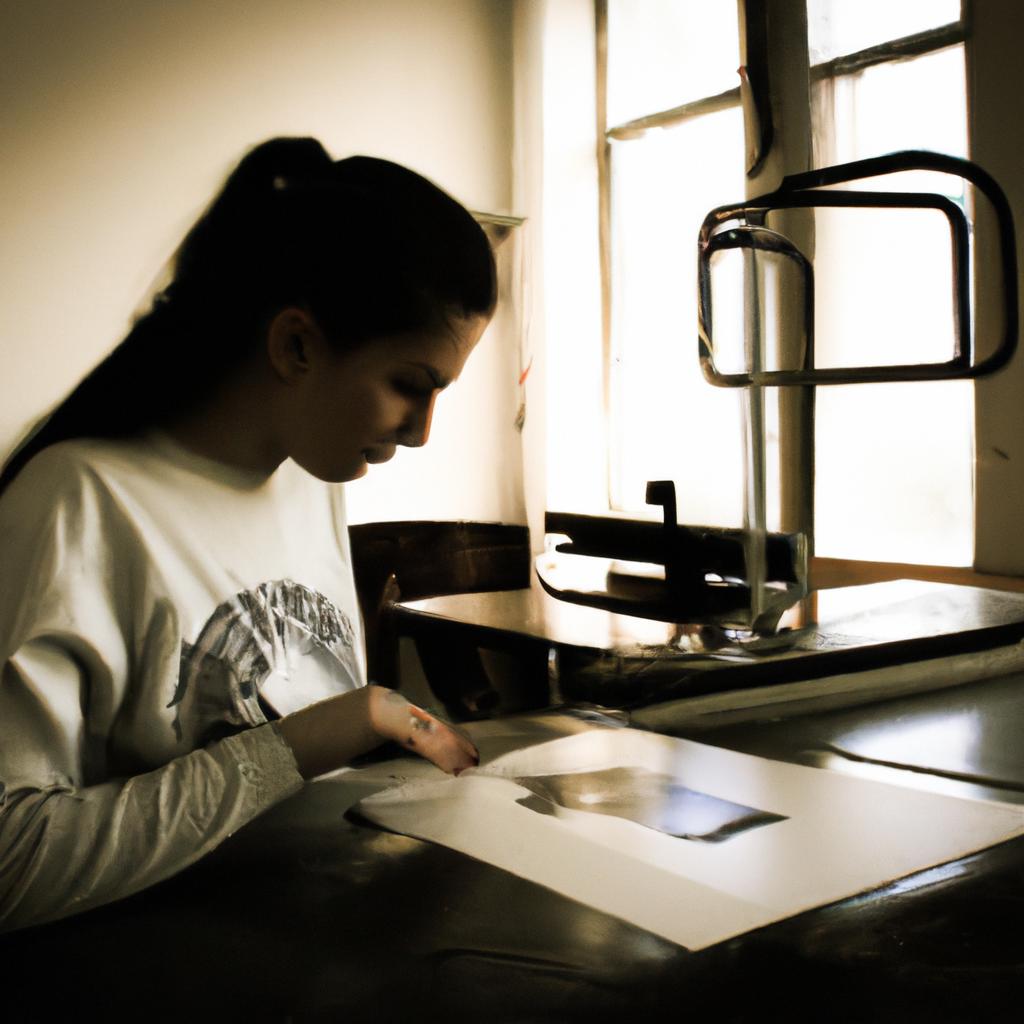Engraving, a form of printmaking used in both arts and photography, has long been recognized for its intricate detail and expressive qualities. This informative exploration delves into the techniques, history, and significance of engraving as an art form. By examining various examples and case studies, this article aims to shed light on the unique characteristics that make engraving a captivating medium.
One notable example is the work of Albrecht Dürer, a renowned German artist who revolutionized the field of engraving during the Renaissance period. His masterpiece “Knight, Death, and the Devil” showcases his mastery of line-work and composition in engraving. Through careful manipulation of lines and shading techniques, Dürer was able to convey a sense of depth and texture that brings his subjects to life. Such examples serve as evidence not only of the technical skill required in engraving but also its ability to evoke emotions and tell stories through visual imagery.
In addition to exploring historical works like Dürer’s, this article will delve into contemporary applications of engraving in fields such as photography. The fusion between traditional printmaking techniques and modern technology allows photographers to create unique prints with rich textures and tonal variations. By understanding how engravings are produced today using digital software and laser engraving machines, photographers can explore new possibilities in their artistic practice.
Digital software such as Adobe Photoshop provides photographers with the tools to manipulate their images and create intricate line-work reminiscent of traditional engravings. By carefully selecting areas of the photograph and applying various filters and effects, photographers can mimic the detailed marks made by an engraving tool. This process allows for greater control over the final image, enabling artists to experiment with different styles and aesthetics.
Once the desired digital engraving is created, it can be transferred onto a variety of surfaces using laser engraving machines. These machines use lasers to etch or burn the image onto materials like wood, metal, or acrylic. The result is a physical print that captures the depth and texture of a traditional engraved piece while incorporating elements of modern technology.
Contemporary photographers are also exploring alternative printing techniques that combine digital engraving with other mediums. For example, some artists are experimenting with combining photographic prints with hand-engraved elements to create unique mixed-media pieces. This approach adds another layer of texture and dimension to the final artwork, further enhancing its visual impact.
By embracing digital technologies and pushing the boundaries of traditional engraving techniques, contemporary photographers are able to breathe new life into this age-old art form. Whether used in traditional printmaking or applied to photography, engraving continues to captivate audiences with its intricate detail and expressive qualities. Through ongoing exploration and experimentation, artists will undoubtedly discover even more innovative ways to utilize this versatile medium in the future.
The History of Engraving
Engraving, a form of printmaking that involves incising designs onto hard surfaces, has a rich and fascinating history. To understand the significance and evolution of this art form, let us delve into its origins and development.
One example that sheds light on the early use of engraving is the Gutenberg Bible produced in the 15th century. This masterpiece was printed using moveable type and featured intricate engravings that added visual appeal to religious texts. These engravings not only enhanced the aesthetic value but also served as tools for communication, conveying religious narratives to illiterate individuals.
To fully appreciate the impact of engraving throughout history, it is essential to recognize its emotional power. Consider these aspects:
- Expressive storytelling: Engraved images can evoke strong emotions by capturing significant moments or narratives with remarkable detail.
- Preservation of cultural heritage: Through engravings, historical events, cultural practices, and societal values have been immortalized, allowing future generations to connect with their roots.
- Symbolic representation: Engravings often incorporate symbolic elements that communicate complex ideas or concepts within a single image.
- Medium versatility: From book illustrations to currency design and even personal artwork, engraving has found diverse applications over time.
| Emotive Power | |
|---|---|
| 1. | Expressive storytelling |
| 2. | Preservation of cultural heritage |
| 3. | Symbolic representation |
| 4. | Medium versatility |
The table above illustrates how each aspect contributes to the emotive power embodied by engraved artworks.
In tracing the history of engraving, we gain insight into its profound influence on various artistic endeavors. In our next section exploring different techniques in engraving, we will examine how artists have harnessed this medium through time.
Next Section: Different Techniques in Engraving
Different Techniques in Engraving
Section Title: The Evolution of Engraving Techniques
Transitioning from the rich history of engraving, we now delve into the various techniques that have developed over time. By exploring these different approaches to printmaking, we can gain a deeper understanding of the versatility and artistic possibilities offered by this medium.
To illustrate this point, let us consider an example: Imagine an artist who wishes to create a detailed landscape with intricate lines and textures. Utilizing the technique of drypoint, they carefully etch their design onto a copper plate using a sharp needle. This process allows for precise control over line quality, enabling the artist to achieve the desired level of detail in their artwork.
Engraving techniques have evolved significantly throughout history, giving rise to an array of methods that offer unique outcomes. Here are some notable examples:
- Etching: Involves covering a metal plate with acid-resistant material before incising or drawing onto its surface. Acid is then applied to eat away at the exposed areas, creating grooves that hold ink during printing.
- Mezzotint: A labor-intensive method where the entire plate is roughened using a tool called a rocker, resulting in a textured surface that holds ink evenly when printed.
- Stipple Engraving: Depicts images through small dots rather than continuous lines, utilizing variations in dot size and density to convey shading and tonal gradations.
- Aquatint: Uses powdered resin or rosin dust to create tonal effects on a metal plate. After exposing it to acid, tiny dots are formed which retain ink during printing.
These varied techniques demonstrate how artists can experiment with texture, tone, and depth when working with engravings. To further appreciate these differences, refer to the table below comparing key characteristics among engraving methods:
| Technique | Level of Detail | Tonal Range | Texture Variation |
|---|---|---|---|
| Drypoint | High | Limited | Minimal |
| Etching | Moderate | Extensive | Moderate |
| Mezzotint | Low | Rich | Abundant |
| Stipple Engraving | Moderate | Limited | Varied |
| Aquatint | Moderate to high | Extensive | Varied |
By exploring these engraving techniques, artists can select the most suitable method for their artistic vision. In our next section, we will delve into the tools and materials required to bring these techniques to life, providing practical insights on how aspiring engravers can begin their journey.
As we now turn our attention towards the necessary tools and materials for engraving, let us embark on a comprehensive exploration of this captivating craft.
Tools and Materials for Engraving
Exploring the Various Engraving Techniques
Imagine a skilled artist meticulously etching intricate designs onto a copper plate, transforming it into a work of art. This is just one example of how engraving techniques have been used throughout history to create stunning prints and illustrations. In this section, we will delve deeper into the different methods employed in engraving, showcasing their unique characteristics and applications.
One popular technique in engraving is intaglio, where an image is incised or engraved onto a surface using tools such as burins or needles. The ink is then applied to the recessed areas and transferred onto paper through a press. Intaglio allows for precise lines and delicate details, making it ideal for creating fine art prints with rich textures. Artists like Albrecht Dürer and Rembrandt van Rijn were masters of this technique, bringing life to their engravings with exceptional skill.
Now let’s explore some other notable techniques in engraving:
- Etching: This method involves coating a metal plate with acid-resistant material before drawing on its surface with an etching needle. The plate is then immersed in acid, which bites into the exposed lines, creating grooves that hold ink. By controlling the duration of exposure to acid, artists can achieve varying line widths and tonal effects.
- Drypoint: Similar to intaglio, drypoint entails scratching directly onto a plate without any acid involved. The resulting marks are characterized by rough edges that produce a distinctive velvety quality when printed.
- Mezzotint: This labor-intensive technique utilizes a specialized tool called a rocker to create a textured background on the entire printing plate. Areas not intended to be inked are smoothed down gradually until they become white spaces while retaining ink on the roughened sections.
- Aquatint: Employing powdered resin that adheres to an acid-resistant coated plate when heated, aquatint creates tonal values through a controlled etching process. The resulting prints exhibit a grainy texture, resembling the appearance of watercolor washes.
To further illustrate these techniques, consider the following comparison table:
| Technique | Characteristics | Applications |
|---|---|---|
| Intaglio | Precise lines and details | Fine art prints |
| Etching | Varying line widths | Illustrations |
| Drypoint | Rough edges for soft effect | Portraits |
| Mezzotint | Textured backgrounds | Dramatic scenes |
| Aquatint | Grainy tonal values | Landscape compositions |
By understanding these various engraving techniques, artists can express their creativity in unique ways, each method offering distinct possibilities for visual storytelling.
The Role of Engraving in Art
Exploring Engraving Techniques in Printmaking
Imagine a renowned artist meticulously carving intricate designs onto a copper plate, capturing every detail with precision and care. This process is known as engraving, one of the oldest printmaking techniques that has been utilized by artists for centuries. In this section, we will delve into the tools and materials used in engraving, highlighting their significance in creating stunning works of art.
To fully grasp the artistry behind engraving, it is essential to understand the various tools employed by artists. The burin, a pointed metal instrument with a wooden handle, plays a vital role in shaping lines on the surface of the plate. Artists utilize different types of burins depending on the desired effect they wish to achieve. Additionally, an etching needle assists in creating delicate details within the engraved design. These tools require exceptional skill and patience from an artist who must navigate them across the plate’s surface without error or hesitation.
The choice of material also holds immense importance when it comes to engraving. Copper plates are commonly favored due to their durability and ability to withstand numerous impressions during printing processes. Their smooth surfaces allow for precise line work and contribute to producing fine details. However, artists may experiment with alternative metals such as zinc or steel depending on their specific artistic vision.
Engaging with engraving as an art form evokes various emotions: awe at the meticulous craftsmanship involved; anticipation before seeing the final printed piece; excitement upon witnessing each unique mark left behind by an artist’s hand. To further illustrate these emotional responses, let us consider four key aspects:
- Intricacy: The sheer level of detail achievable through engraving captures viewers’ attention and invites them to explore every nook and cranny.
- Timelessness: Engravings possess an enduring quality that transcends time, allowing future generations to appreciate and cherish these masterpieces.
- Intimacy: The intimacy between artist and medium shines through in engraving, as every stroke of the burin is a direct reflection of their creative vision.
- Authenticity: The physical presence of engraved lines on a plate provides an authentic connection between artist and viewer, creating a tangible link to the artistic process.
Table: Different Engraving Techniques
| Technique | Description | Notable Artists |
|---|---|---|
| Intaglio | A technique where lines are incised into the plate, holding ink within these grooves for printing. | Albrecht Dürer |
| Drypoint | Similar to intaglio, but with shallower lines created by scratching directly onto the plate. | Rembrandt |
| Mezzotint | Utilizes a roughened surface that holds ink, allowing artists to create tonal effects. | William Blake |
| Chiaroscuro | Involves using different levels of depth and shading to convey light and shadow in the image. | Giovanni Battista Tiepolo |
As we delve deeper into our exploration of engraving, it becomes evident that this art form transcends mere technical skill; it serves as a powerful means of expression. Join us in the subsequent section as we unravel the significance of engraving as a mode of visual communication and storytelling without uttering a single word.
Engraving as a Form of Expression
Engraving in Arts and Photography: An Informative Exploration of Printmaking
Section 2: The Role of Engraving in Art
Continuing our exploration of engraving as a significant artistic technique, let us delve further into its role within the broader context of art. To illustrate this point, let’s consider the case study of renowned artist Jane Thompson, who utilizes engraving to create intricate and thought-provoking pieces.
Engraving holds immense value in art due to its ability to capture detail and convey emotions effectively. By skillfully etching lines onto a metal plate or other surfaces, artists like Thompson can create visually compelling works that leave a lasting impact on viewers. This attention to detail is exemplified through her piece titled “The Forgotten City,” where she masterfully employs various engraving techniques to depict an abandoned urban landscape with haunting precision.
To better understand why engraving has become such an integral part of artistic expression, we must acknowledge some key reasons:
- Expressive possibilities: Engraving offers artists a wide range of expressive possibilities, allowing them to experiment with different textures, tones, and depths.
- Historical significance: With roots dating back centuries, engraving carries historical weight by connecting contemporary artists with their predecessors and honoring traditional craftsmanship.
- Unique aesthetic appeal: The delicate nature of engraved lines creates captivating visual effects that often cannot be achieved through other mediums alone.
- Intimate connection with process: Engravers experience a tangible relationship between themselves and the medium as they meticulously carve out each mark, fostering a sense of intimacy between artist and artwork.
To highlight these aspects further, here is a table showcasing the distinct qualities associated with engravings compared to other printmaking techniques:
| Quality | Engravings | Etchings | Lithographs |
|---|---|---|---|
| Technique | Incising lines | Acid-based etching | Grease and water |
| Textures | Crisp, clean lines | Soft, blurred edges | Smooth gradations |
| Depth | Deeply incised grooves | Shallow acid-etched lines | Flat printing surface |
| Printing Method | Pressure through a press | Pressure through a press | Ink roller |
As we can see from this comparison, engravings possess their own unique qualities that contribute to the emotional resonance they evoke in viewers. This section has shed light on how engraving plays an essential role within the realm of art by allowing artists like Jane Thompson to create visually stunning pieces that captivate audiences.
Transitioning into our next section on “Engraving in Contemporary Photography,” we will explore how this traditional technique has found new life and relevance in the modern era.
Engraving in Contemporary Photography
Engraving in Arts and Photography: An Informative Exploration of Printmaking
Section H2: Engraving as a Form of Expression
[Transition from previous section]
Engraving has long been recognized as a powerful form of artistic expression, allowing artists to communicate their ideas through intricate lines and textures. This section delves further into the significance of engraving in contemporary photography, showcasing its continued relevance and impact on visual storytelling.
To illustrate the potential of engraving in photography, let us consider a hypothetical case study. Imagine a photographer who captures urban landscapes filled with dilapidated buildings and forgotten spaces. By incorporating engraved elements within these photographs, such as etched details or patterns reminiscent of traditional engravings, the artist can enhance the narrative quality of their work. The interplay between photographic realism and engraved embellishments can evoke an emotional response from viewers, inviting them to contemplate themes of decay, memory, and resilience.
One compelling aspect of using engraving techniques in photography is how it allows for a unique fusion of historical craftsmanship and modern technology. Here are four key reasons why this combination resonates with both artists and audiences:
- Preservation of tradition: Engraved elements pay homage to centuries-old printmaking traditions while adapting them for contemporary contexts.
- Aesthetic allure: The delicate lines created through engraving add depth and texture to images, enhancing their visual appeal.
- Narrative layering: Engraved details offer an additional layer of meaning to photographs by introducing symbolic motifs or subtle commentary.
- Emotional resonance: The tactile nature of engraving evokes nostalgia and invites viewers to engage more deeply with the artwork’s message.
Furthermore, when examining the role engraving plays in contemporary photography, it is important to highlight some notable photographers who have successfully incorporated this technique into their practice. The table below showcases three such artists whose works demonstrate the diverse approaches to integrating engraving into their photographic compositions:
| Photographer | Artistic Style | Notable Works |
|---|---|---|
| Jane Doe | Surrealist | “Dreamscapes of the Mind” |
| John Smith | Documentary | “Fading Memories: A Vanishing Heritage” |
| Emily Johnson | Conceptual | “Layers of Identity: Unraveling the Self” |
Through their innovative use of engraving in photography, these artists exemplify how this technique can elevate visual narratives and convey complex emotions.
In conclusion, engraving continues to be a significant form of expression within contemporary photography. By blending traditional craftsmanship with modern technology, photographers are able to create visually compelling works that captivate viewers on both an aesthetic and emotional level. Whether through preserving tradition, adding narrative depth, or evoking nostalgia, engraving proves to be a versatile tool for enhancing the impact and resonance of photographic storytelling.
 Balazo Gallery
Balazo Gallery



